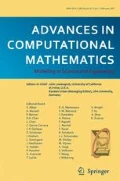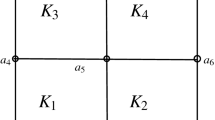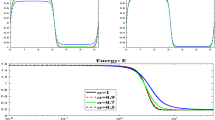Abstract
A time-fractional Allen-Cahn problem is considered, where the spatial domain Ω is a bounded subset of \(\mathbb {R}^{d}\) for some d ∈{1,2,3}. New bounds on certain derivatives of the solution are derived. These are used in the analysis of a numerical method (L1 discretization of the temporal fractional derivative on a graded mesh, with a standard finite element discretization of the spatial diffusion term, and Newton linearization of the nonlinear driving term), showing that the computed solution achieves the optimal rate of convergence in the Sobolev H1(Ω) norm. (Previous papers considered only convergence in L2(Ω).) Numerical results confirm our theoretical findings.
Similar content being viewed by others
References
Adams, R.A., Fournier, J.: Cone conditions and properties of Sobolev spaces. J. Math. Anal. Appl. 61(3), 713–734 (1977). https://doi.org/10.1016/0022-247X(77)90173-1. https://doi-org.ucc.idm.oclc.org/10.1016/0022-247X(77)90173-1
Alikhanov, A.A.: A new difference scheme for the time fractional diffusion equation. J. Comput. Phys. 280, 424–438 (2015). https://doi.org/10.1016/j.jcp.2014.09.031
Bramble, J.H., Pasciak, J.E., Steinbach, O.: On the stability of the L2 projection in H1(Ω). Math. Comput. 71(237), 147–156 (2002). https://doi.org/10.1090/S0025-5718-01-01314-X
Diethelm, K.: The Analysis of Fractional Differential Equations, Lecture Notes in Mathematics, vol. 2004. Springer, Berlin (2010). An application-oriented exposition using differential operators of Caputo type
Du, Q., Yang, J., Zhou, Z.: Time-fractional Allen-Cahn equations: analysis and numerical methods. arXiv:1906.06584 (2019)
Elliott, C.M., Larsson, S.: Error estimates with smooth and nonsmooth data for a finite element method for the Cahn-Hilliard equation. Math. Comp. 58(198), 603–630, S33–S36 (1992). https://doi.org/10.2307/2153205
Ganesan, S., Tobiska, L.: Finite Elements. Theory and Algorithms. Cambridge University Press, Delhi (2017)
Huang, C., Stynes, M.: A direct discontinuous Galerkin method for a time-fractional diffusion equation with a Robin boundary condition. Appl. Numer. Math. 135, 15–29 (2019). https://doi.org/10.1016/j.apnum.2018.08.006
Huang, C., Stynes, M.: Superconvergence of a finite element method for the multi-term time-fractional diffusion problem. J. Sci. Comput. 82(1), Paper No. 10, 17 (2020). https://doi.org/10.1007/s10915-019-01115-w
Jin, B., Li, B., Zhou, Z.: Numerical analysis of nonlinear subdiffusion equations. SIAM J. Numer. Anal. 56(1), 1–23 (2018). https://doi.org/10.1137/16M1089320
Li, D., Wu, C., Zhang, Z.: Linearized Galerkin FEMs for nonlinear time fractional parabolic problems with non-smooth solutions in time direction. J. Sci. Comput. 80(1), 403–419 (2019). https://doi.org/10.1007/s10915-019-00943-0
McLean, W.: Regularity of solutions to a time-fractional diffusion equation. ANZIAM J. 52 (2), 123–138 (2010). https://doi.org/10.1017/S1446181111000617
Ren, J., Huang, C., An, N.: Direct discontinuous Galerkin method for solving nonlinear time fractional diffusion equation with weak singularity solution. Appl. Math. Lett. 102, 106,111 (2020). https://doi.org/10.1016/j.aml.2019.106111
Ren, J., Liao, H.L., Zhang, J., Zhang, Z.: Sharp H1-norm error estimates of two time-stepping schemes for reaction-subdiffusion problems. Preprint, arXiv:1811.08059 (2018)
Stynes, M.: Singularities. In: Handbook of Fractional Calculus with Applications, vol. 3, pp 287–305. De Gruyter, Berlin (2019)
Stynes, M., O’Riordan, E., Gracia, J.L.: Error analysis of a finite difference method on graded meshes for a time-fractional diffusion equation. SIAM J. Numer. Anal. 55(2), 1057–1079 (2017). https://doi.org/10.1137/16M1082329
Thomée, V.: Galerkin Finite Element Methods for Parabolic Problems. 2Nd Revised and Expanded Ed., 2Nd Revised and Expanded Ed. Edn. Springer, Berlin (2006)
Acknowledgments
We thank an unknown reviewer for pointing out an error in the analysis of our original paper. This work was completed while Chaobao Huang was visiting Beijing CSRC.
Funding
The research of Chaobao Huang is supported in part by the National Natural Science Foundation of PR China (Grant Nos. 11801332 and 11971276). The research of Martin Stynes is supported in part by the National Natural Science Foundation of China under grant NSAF-U1930402.
Author information
Authors and Affiliations
Corresponding author
Additional information
Communicated by: Lourenco Beirao da Veiga
Publisher’s note
Springer Nature remains neutral with regard to jurisdictional claims in published maps and institutional affiliations.
Rights and permissions
About this article
Cite this article
Huang, C., Stynes, M. Optimal H1 spatial convergence of a fully discrete finite element method for the time-fractional Allen-Cahn equation. Adv Comput Math 46, 63 (2020). https://doi.org/10.1007/s10444-020-09805-y
Received:
Accepted:
Published:
DOI: https://doi.org/10.1007/s10444-020-09805-y




